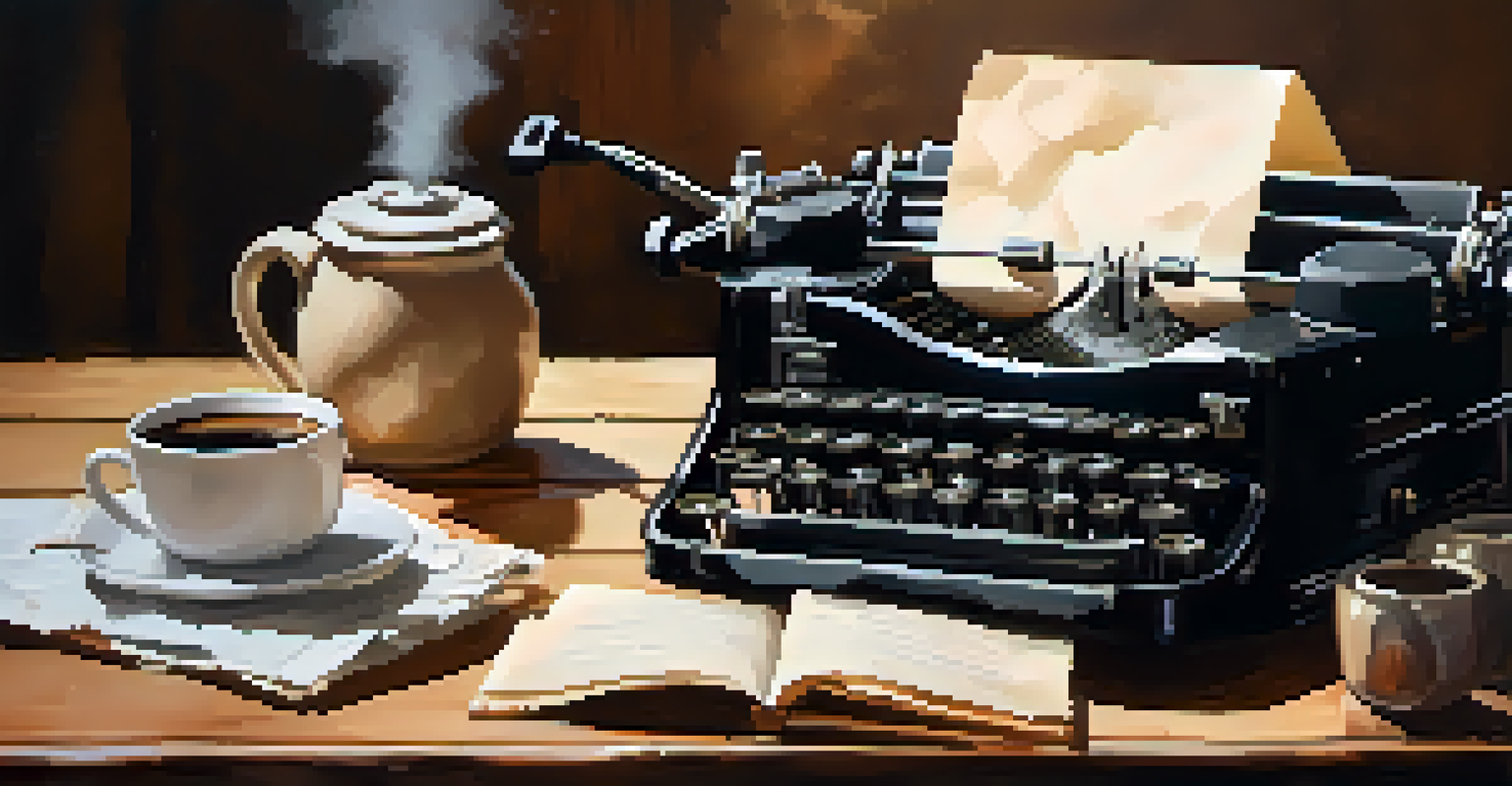The Influence of Entheogens on Beat Generation Literature

Understanding Entheogens and Their Role
Entheogens are substances that, when consumed, can lead to altered states of consciousness, often used in spiritual contexts. The term comes from the Greek words 'entheos,' meaning 'full of the god,' and 'genes,' meaning 'generated by.' These substances played a significant role in the creative processes of Beat Generation writers, who sought deeper truths beyond conventional boundaries.
The only thing that matters is that you can hear it and that it’s true, and that it’s beautiful.
For many Beat writers, entheogens served as catalysts for exploration, pushing the limits of perception and understanding. Authors like Allen Ginsberg and William S. Burroughs embraced these substances to challenge societal norms and express their experiences in innovative ways. The influence of these mind-altering agents can be seen in their vivid imagery and experimental writing styles.
By integrating entheogens into their creative routines, these writers aimed to tap into profound insights and authentic experiences. This quest for deeper meaning not only shaped their literature but also contributed to a broader cultural movement that sought liberation from traditional constraints.
The Beats: A Brief Overview
The Beat Generation, emerging in the 1950s, was a literary movement characterized by its rejection of mainstream values and exploration of spirituality, sexuality, and personal freedom. Key figures like Jack Kerouac, Ginsberg, and Burroughs sought to capture the essence of the human experience through their works, often blending autobiographical elements with fiction. Their writings resonated with a sense of rebellion and a longing for authenticity.

Central to the Beat ethos was an embrace of spontaneity and a desire to break free from societal constraints. This often manifested in their unconventional lifestyles and a search for alternative forms of expression. Through their literature, the Beats challenged the status quo, encouraging readers to question their own lives and the world around them.
Entheogens Shape Beat Literature
Entheogens served as catalysts for Beat writers like Ginsberg and Burroughs, influencing their creative processes and challenging societal norms.
As they navigated a rapidly changing society, the Beats drew inspiration from various sources, including jazz music, Eastern philosophies, and, of course, entheogens. This eclectic mix of influences helped shape a unique literary voice that continues to inspire generations of writers and artists.
Ginsberg and the Psychedelic Experience
Allen Ginsberg, one of the most prominent figures of the Beat Generation, famously explored the psychedelic experience in his poetry. Works like 'Howl' reflect his engagement with both societal issues and personal struggles, often heightened by his use of entheogens. Ginsberg sought to convey the intensity of his experiences, making readers feel the weight of his insights.
Your mind is like a parachute. It doesn’t work if it isn’t open.
His relationship with substances like marijuana and LSD was not merely recreational; it was a means to unlock deeper layers of consciousness. Ginsberg believed that these experiences could lead to spiritual awakenings, allowing individuals to connect with a greater sense of unity and understanding. This belief is evident in the way he weaves themes of transcendence and interconnectedness throughout his poetry.
Ginsberg’s candid approach to discussing drugs in his work helped destigmatize their use among artists and intellectuals. By sharing his experiences, he encouraged others to explore their own consciousness and seek out new perspectives, ultimately shaping the cultural landscape of the 1960s and beyond.
Burroughs and the Cut-Up Technique
William S. Burroughs, another key Beat writer, utilized entheogens not only for inspiration but also as a tool for experimentation in form. His innovative cut-up technique, which involved rearranging text to create new meanings, mirrored the disorienting effects of substances like heroin and psychedelics. This method allowed Burroughs to challenge linear narrative structures, reflecting the chaotic nature of his experiences.
In works such as 'Naked Lunch,' Burroughs employed entheogens as a lens through which to explore themes of addiction, control, and the human psyche. The fragmented narrative structure and surreal imagery in his writing echo the unpredictable nature of his drug experiences, inviting readers into a world that defies conventional understanding. His work often serves as a commentary on the darker aspects of society, revealing the struggles faced by those caught in the throes of addiction.
The Beats Embrace Spontaneity
The Beat Generation's focus on spontaneity and authenticity in writing reflected a desire to break free from conventional constraints and explore the human experience.
By embracing entheogens and their effects, Burroughs pushed the boundaries of literature, encouraging readers to confront their own realities. His legacy continues to inspire writers to experiment with form and content, fostering a spirit of innovation within the literary community.
Kerouac and Spontaneity in Writing
Jack Kerouac, the quintessential Beat writer, is best known for his novel 'On the Road,' which captures the essence of the Beat spirit through a spontaneous, free-flowing narrative style. While Kerouac's use of entheogens was less pronounced than that of Ginsberg or Burroughs, he embraced the principles of spontaneity and authenticity that these experiences often fostered. His writing reflects a desire to capture the rawness of life as it unfolds.
Kerouac’s approach to writing was influenced by his quest for spiritual enlightenment, often paralleling the journeys undertaken by those who explore entheogens. He sought to break free from traditional literary conventions, favoring a stream-of-consciousness style that mirrored the ebb and flow of thoughts and experiences. This emphasis on spontaneity can be seen as a reflection of the chaotic beauty of life itself.
Through his travels across America, Kerouac sought connection with others, the landscape, and ultimately, himself. His works resonate with a sense of exploration and adventure, inviting readers to embark on their own journeys of self-discovery. The influence of entheogenic experiences, though subtle, permeates the fabric of his literary voice, reinforcing the idea that creativity often flourishes in moments of genuine spontaneity.
Cultural Context and the 1960s
The cultural climate of the 1960s played a crucial role in amplifying the influence of entheogens on Beat literature. As social movements advocating for civil rights, anti-war sentiments, and countercultural ideas gained momentum, artists and writers sought new avenues for expression. The Beats, in particular, became prominent voices in this shifting landscape, using their work to reflect the zeitgeist of the time.
Entheogens were increasingly viewed as tools for personal liberation and social change, aligning with the Beats’ core values of challenging conformity and seeking authenticity. This growing acceptance of psychedelic substances created a fertile ground for experimentation in literature and art. The connection between mindfulness, spirituality, and creativity became more pronounced, inspiring a wave of writers to explore these themes.
Legacy of Beats in Modern Writing
The influence of the Beat Generation's exploration of entheogens continues to resonate in contemporary literature, inspiring modern authors to challenge norms and seek deeper understanding.
As the counterculture movement gained traction, the Beats became cultural icons, embodying the spirit of rebellion and exploration. Their works not only shaped literature but also influenced music, visual arts, and societal attitudes toward consciousness. The legacy of the Beat Generation endures, reminding us of the transformative power of creativity and the ongoing quest for deeper understanding.
Legacy of Entheogens in Modern Literature
The influence of entheogens on Beat Generation literature continues to resonate in contemporary writing. Modern authors often draw inspiration from the Beats' willingness to explore altered states of consciousness and challenge societal norms. This legacy is evident in various genres, including poetry, fiction, and memoirs, as writers seek to capture the complexities of human experience.
In recent years, there has been a resurgence of interest in entheogens, both in popular culture and academic circles. As discussions around mental health, spirituality, and creativity evolve, many contemporary writers are revisiting the themes explored by the Beats. This renewed focus on entheogens as potential tools for self-discovery and healing has opened new avenues for exploration in literature.

Ultimately, the Beats’ innovative approach to writing and their embrace of entheogenic experiences invite modern authors to push boundaries and seek authenticity in their work. The ongoing dialogue surrounding these substances and their impact on creativity serves as a testament to the enduring legacy of the Beat Generation and its influence on the literary landscape.